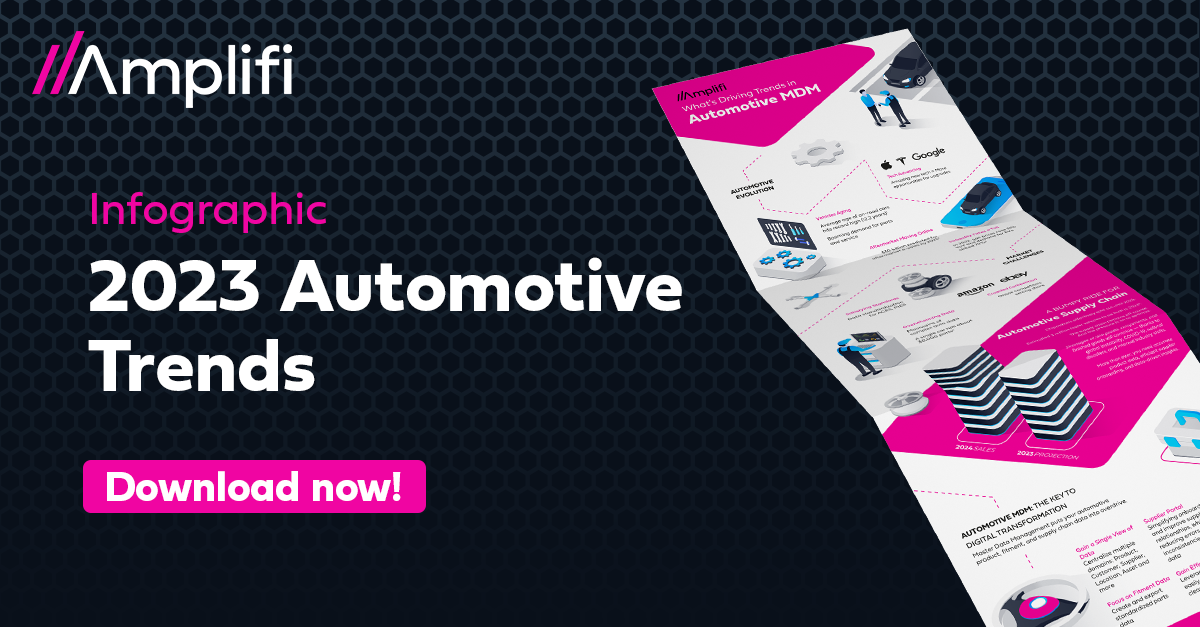As an automotive manufacturer, you know the pressure of dealing with large volumes of data. You may struggle to handle the complexity of multiple systems and sources related to suppliers, customers, products, and production sites.
This data is not only vast but also connected. Understanding those connections is crucial to making informed decisions about how to grow your business.
Recently, we shared how PIM can help automotive manufacturers tackle some of their biggest challenges. But did you know there’s far more you can accomplish when you think beyond PIM?
In this blog, we’re continuing our series with Stibo Systems by exploring how you can unlock the full potential of your data with a holistic approach.
What is a multi-domain MDM approach for automotive manufacturers?
Historically, the automotive industry has relied on disparate systems to organize different types of data. The result is often data silos, gaps, and blind spots. Not only is the data hard to find and manage, but it’s also nearly impossible to compare or analyze.
This is where multi-domain MDM comes into play.
Multi-domain MDM is a holistic approach that allows automotive manufacturers to manage various data types in a single platform. This helps you gain intelligence around data relationships—for example, between products and suppliers—to drive better business decisions.
Recommended Infographic: Current Trends in Automotive MDM
What domains of data should automotive manufacturers focus on?
The automotive industry has much to gain from MDM, including managing extensive information about how and where a product is made, who supplies it, where it’s sold, and who buys it.
That’s why manufacturers often start with product data.
Product data is crucial for managing a vast catalog of products and aftermarket parts. A golden record of product data helps you launch products quickly, publish data to e-commerce sites, and meet standards like ACES and PIES.
When you pair product data with digital asset management (DAM), you gain even more efficiency related to managing all the images, videos, manuals, and documents required to produce, sell, and support your products.
Because of the scalability of multi-domain MDM, automotive manufacturers often start with one data category, such as Product, and then gradually add other areas as their needs change. This approach ensures the implementation isn’t overwhelming and keeps a manageable pace.
Start or expand your implementation with Customer or Supplier data.
When “thinking beyond PIM,” you may want to consider Customer or Supplier data domains.
Customer data helps automotive manufacturers resolve variations around spellings, names, and addresses. Once you have a golden customer record, you can leverage it to enhance personalization, boost sales with targeted offers, and maintain compliance with data privacy standards.
In today’s world, where the automotive industry experiences extreme supply chain disruption, Supplier data is essential. The global microchip shortage, for example, continues to cause production delays. And Aftermarket News notes that chipmakers are essentially sold out until 2024.
By utilizing Supplier data, automotive manufacturers gain greater visibility into their supplier network — for example, which suppliers have chips in stock closest to your manufacturing plants.
Once you find a supplier with stock, you can leverage a Supplier Portal to rapidly onboard that vendor and upload their data. The benefits also include improving collaboration, optimizing costs, viewing performance issues, and negotiating better deals.
Consider other “small but mighty” data domains that can transform your business.
Product, Customer, and Supplier data get the most hype. But there are other types of data that deliver tremendous results. The key is to evaluate your business challenges and create a data model that meets your most urgent needs.
For example, by utilizing Location data, automotive manufacturers can optimize logistics and price products appropriately based on local market conditions. Location data can also help you manage compliance with regulations and environmental standards, such as tracking emissions from different manufacturing plants.
Utilizing Asset data can help manufacturers stay on top of equipment maintenance schedules and comply with safety standards. In addition, Parts & Materials data can alleviate the crunch felt by tracking detailed information related to sourcing, replicating, and replacing parts or materials across many locations.
The key is to connect the dots
Along with the typical benefits of MDM, a multi-domain approach delivers a key advantage: cross-domain intelligence. In other words, the insights you glean from analyzing the relationships between data.
Which products are in high demand from your most profitable customers? How can you ship your products at a lower cost? Which suppliers no longer meet your needs? Are your production sites operating safely and efficiently? Which parts or products are slowing them down?
These are just a few questions auto manufacturers can answer by connecting the data dots.
What’s the best way for automotive manufacturers to adopt multi-domain MDM?
As you can see, there really is no limit to a multi-domain MDM approach. In fact, the potential is so vast that it can feel overwhelming. Where do you start?
Multi-domain MDM is more than technology. It’s a mindset. Platform selection is part of this process, but how you implement your data program is just as important.
Consider: What domains will work best for your business? What are the processes you need? What practices will help you maintain, grow, and support long-term ROI?
A partner who understands the nuances of automotive can help you navigate all the elements of a successful data strategy and implementation.
We also work with technology partners, like Stibo Systems, who have a proven track record in automotive multi-domain MDM.
To learn more, download our Automotive Infographic.


